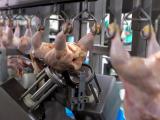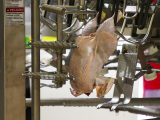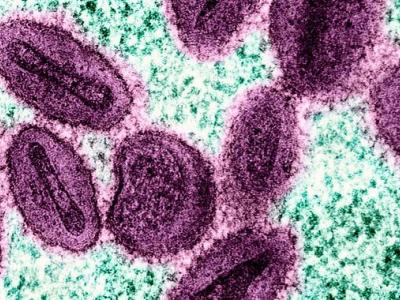Oct 26, 2005 (CIDRAP News) – Chronic wasting disease (CWD), a prion disease that resembles bovine spongiform encephalopathy (BSE), has been found in a wild moose for the first time, Colorado wildlife officials announced recently.
A bull moose that was killed by a bow hunter in September tested positive for the disease, the Colorado Division of Wildlife (DOW) announced Sep 29. Previously the disease had been found in the wild only in deer and elk.
After the initial announcement, the test was repeated and again came up positive, DOW spokesman Tyler Baskfield told CIDRAP News.
The only previous finding of CWD in a moose was in an experiment in which a captive moose was fed some infective material, Baskfield said. "This is the first time a wild moose anywhere has been confirmed with CWD," he said.
The moose was killed in north-central Colorado, near Walden, Baskfield said. "It was in an area where the disease had been found in deer and elk. Obviously it's all speculation how the moose contracted the disease, but I think it would be a reasonable assumption" that the case was linked to diseased deer or elk.
Since 2003, Colorado has required moose hunters to submit the head of the animal for CWD testing, Baskfield said. "We wanted as much information as possible and we wanted to know if that jump [between species] was being made in the wild," he explained.
Since the rule took effect, 288 moose have been tested, with no other cases found, Colorado officials said. But 175 cases were found among nearly 13,000 deer and elk tested between August 2004 and April 2005.
"This is a single case of CWD in moose, but given their social habits we believe that cases in moose are likely to be a rare occurrence," Mike Miller, DOW wildlife veterinarian, said in the news release. Unlike deer and elk, moose are typically solitary and stay with other moose only in cow-calf pairs, the statement said.
Will Hueston, DVM, an expert on BSE and related diseases, told CIDRAP News that the Colorado finding "demonstrates that the CWD agent has a broader range than we hoped. Everyone hoped it would be restricted to deer and elk." He is director of the University of Minnesota Center for Animal Health and Food Safety in St. Paul.
CWD has now been found in wild deer and elk in eight states, including four states east of the Mississippi, plus two Canadian provinces, according to the Chronic Wasting Disease Alliance, a coalition of wildlife conservation groups. The disease was first identified in the wild in Colorado elk in 1981, according to the Centers for Disease Control and Prevention.
The disease has aroused fear that consumers of meat from infected deer or elk could contract a brain-wasting illness like variant Creutzfeldt-Jakob disease, the human equivalent of BSE. So far that hasn't been known to happen, according to Hueston.
He said a team of federal and state investigators analyzed clusters of neurologic disease in humans and found no "compelling evidence" of a link with CWD. Their report was published in June 2004 in Emerging Infectious Diseases.
Likewise, state epidemiologists in Colorado have found no connection between CWD and any human neurologic diseases, the DOW statement said
Commenting on how a moose might contract CWD, Hueston said, "Most animals are inquisitive and . . . it wouldn't surprise me that if a moose came across a deer carcass, they might nose it around it the same as other animals do."
He said the Colorado finding "shows that the chapter about CWD has not been completed yet."
See also:
June 2004 Emerging Infectious Diseases article on CWD
http://www.cdc.gov/ncidod/EID/vol10no6/03-1082.htm
Chronic Wasting Disease Alliance map of CWD-affected states
http://www.cwd-info.org/index.php/fuseaction/about.map



















